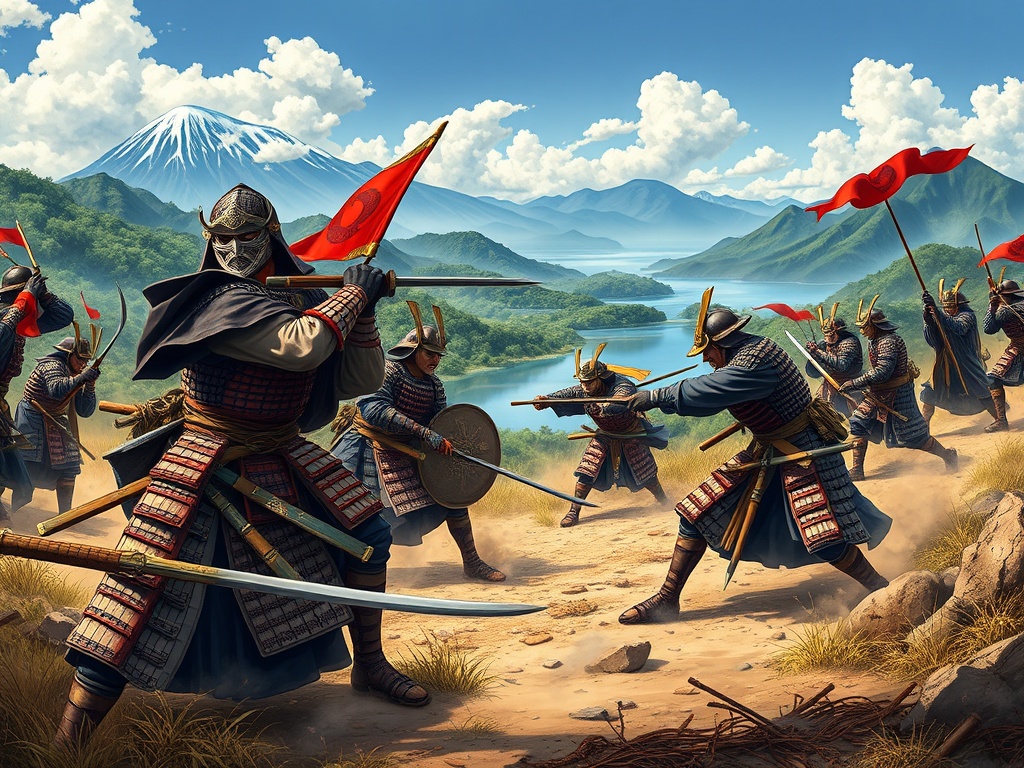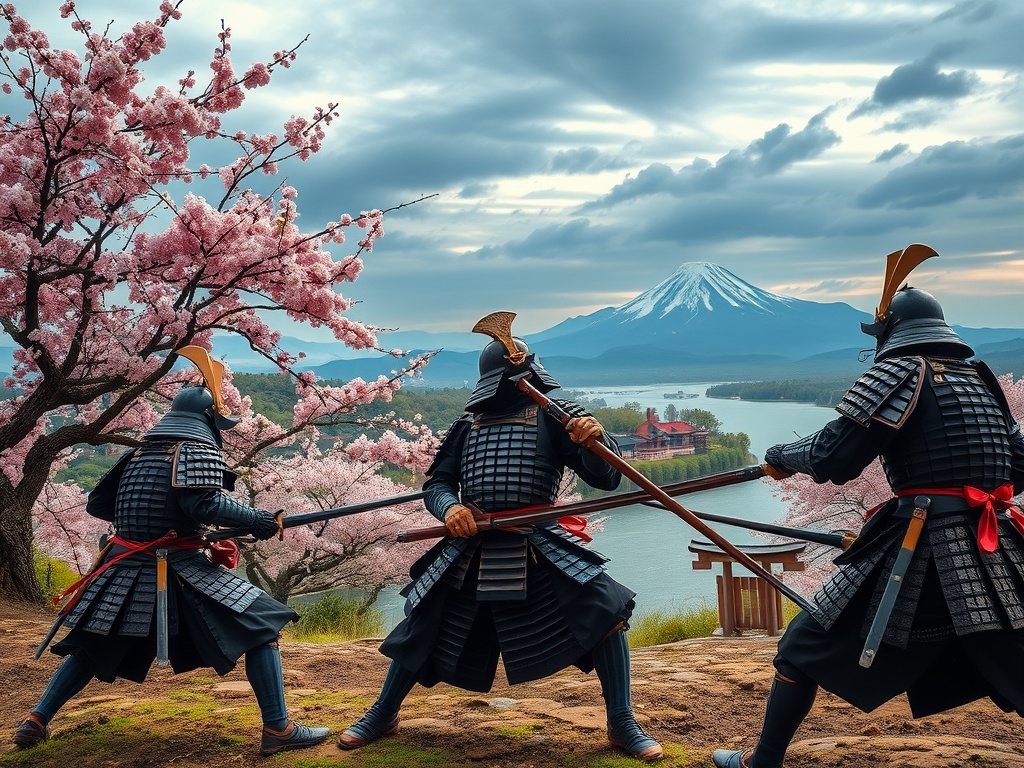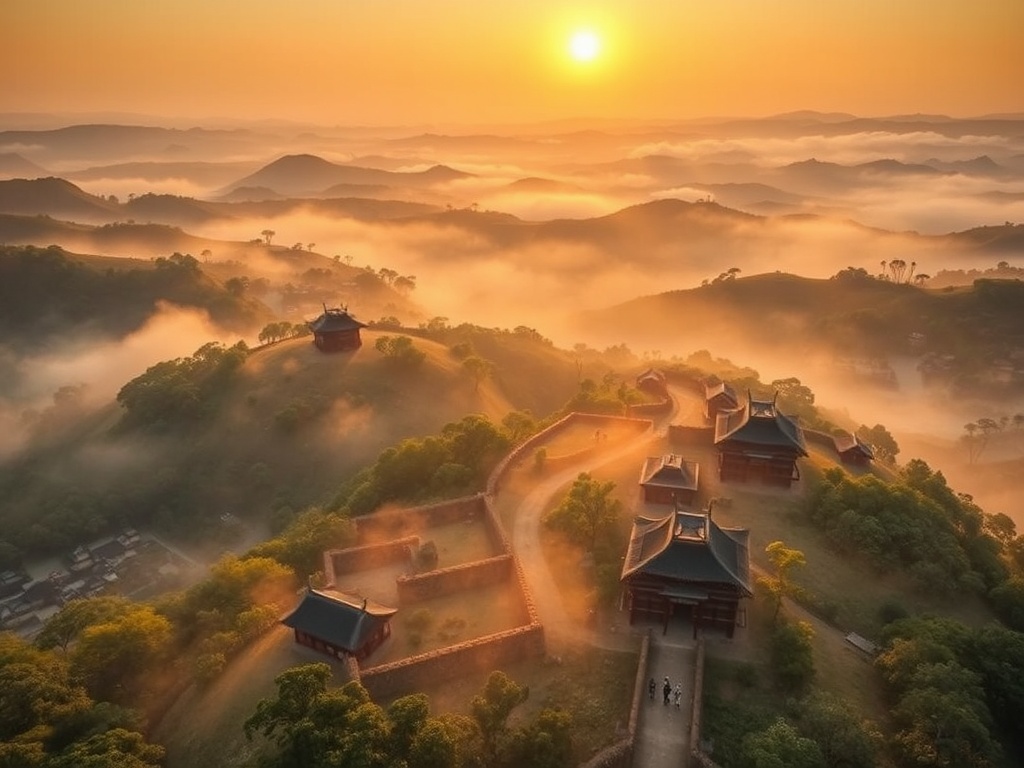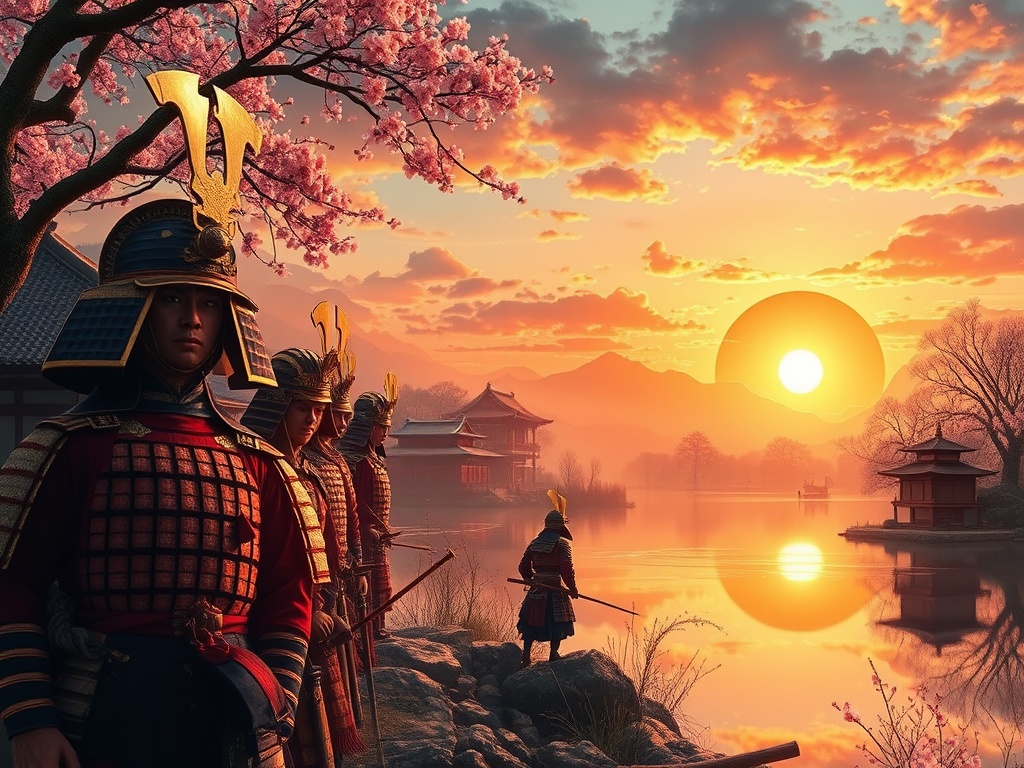Samurai Showdown: The Legendary Clashes of the Genpei War
Win a Free Trip to Japan!
Experience cherry blossoms and ancient temples
Step into the tumultuous era of Japan’s Genpei War, a conflict that not only shaped the future of the nation but also birthed the legendary samurai culture. From the fierce battles to the strategic maneuvers, the Genpei War offers a historical tapestry that is both mesmerizing and educational for travel and tourism enthusiasts. This guide takes you through the highlights of this epic period, where valor and destiny intertwined.
Throughout Japan, the echoes of the Genpei War still resonate in the valleys and fields where samurai once clashed. These historic battlefields are crucial stops for any history buff visiting Japan.
- Dan-no-ura: The site of the final, decisive battle, where the Taira clan met their dramatic end. This coastal site offers not only historical insights but also stunning views of the Kanmon Straits.
- Kurikara: Known for the Battle of Kurikara Pass, where strategic genius defeated sheer numbers. The picturesque surroundings belie the fierce conflict that once raged here.
- Uji: A key site of multiple skirmishes, including the famous Battle of Uji Bridge. The serene landscape today contrasts sharply with its violent past.
The Genpei War was not just a showcase of brute strength but also a testament to the strategic brilliance of the samurai. Understanding their tactics offers a window into the mind of the medieval warrior.
| Strategy | Description |
|---|---|
| Feigned Retreat | A deceptive maneuver used to lure enemy forces into a trap, exemplified in the Battle of Kurikara. |
| Naval Engagements | Naval battles were crucial, with the Battle of Dan-no-ura being a pivotal sea clash that decided the war. |
| Archery and Cavalry | Samurai’s mastery of archery on horseback was a defining feature, showcasing their unparalleled skill. |
Epic Battlescapes: Touring the Iconic Battlefields of 1185
Embark on a journey through time as you traverse the legendary landscapes of the Genpei War. The year 1185 marked a turning point in Japanese history, where valor met strategy and legends were born. These iconic battlefields not only offer a glimpse into the past but also stand as living museums, preserving the tales of heroism and tactical ingenuity that shaped the samurai era. For those passionate about history and adventure, these sites promise an unforgettable experience.
Discover the sites where the samurai spirit was forged. Each location tells a story of heroism, strategy, and the indomitable spirit of the warriors who fought there. These battlefields are more than just historical relics; they are places where the past comes alive, inviting you to walk in the footsteps of legendary samurai.
- Yashima: A dramatic cliff-top setting where the Taira clan made their last stand before their final defeat at Dan-no-ura. The breathtaking views offer a poignant reminder of the battle’s intensity and the strategic brilliance employed by both sides.
- Ichinotani: Witness the rugged terrain that served as the backdrop for one of the war’s most daring engagements. Here, Minamoto no Yoshitsune executed a surprise attack that shifted the war’s momentum, showcasing his tactical genius.
- Shinowara: A lesser-known yet pivotal battlefield where the tides of war shifted dramatically. This site provides a more intimate glimpse into the conflict’s complexities and the lesser-told stories of the warriors who fought here.
Understanding the strategic depth of the Genpei War enhances your appreciation of these historic sites. The samurai were not only skilled swordsmen but also master tacticians who used the landscape to their advantage. Their ability to adapt and innovate on the battlefield remains a subject of admiration and study.
Explore these battlefields and more as you delve into the heart of samurai culture. Each step through these storied grounds offers a connection to the past, a chance to witness the legacy of the warriors who shaped Japan’s future.
Warriors’ Legacy: Exploring the Cultural Impact of the Genpei War
The Genpei War of 1185 wasn’t just a series of battles; it was a transformative epoch that left an indelible mark on Japanese culture. As you explore this historic period, you’ll uncover how the conflict transcended mere military engagements to become a foundational element of Japan’s identity. This guide invites you to delve into the rich tapestry of cultural evolution sparked by the Genpei War, a journey that will deepen your understanding and appreciation of Japan’s storied past.
The Genpei War heralded the rise of the samurai ethos, a code of honor and conduct that would define Japanese society for centuries. This was a time when valor and loyalty became paramount virtues, immortalized in the tales of warriors like Minamoto no Yoshitsune. As you traverse the lands once trodden by these legendary figures, you’ll gain insight into how their ideals shaped the moral and social fabric of Japan. The echoes of their legacy are not only found in ancient texts but also in the modern practices and beliefs that continue to influence Japanese culture today.
The Genpei War’s influence extended beyond the battlefield, weaving its way into the very art and traditions of Japan. The war inspired an array of cultural artifacts, from the intricate armor and weaponry of the samurai to the evocative poetry and literature that commemorated their deeds. Museums and historical sites throughout Japan offer a glimpse into these relics, allowing visitors to connect with the past in a tangible way. Additionally, traditional festivals and reenactments breathe life into the stories of the Genpei War, offering a vibrant celebration of history that captivates both locals and travelers alike.
Tales from the Taira: Unraveling the Mysteries of Japan’s Ancient Clans
Embark on a captivating journey into the heart of Japan’s ancient clans, where the legacy of the Taira clan unfolds like an intricate tapestry of ambition, power, and eventual downfall. The Taira clan, one of the most influential families during the Genpei War, left behind a myriad of stories that continue to intrigue historians and travelers alike. As you delve into these tales, you’ll uncover not just the historical events of the era, but also the cultural nuances that defined a pivotal period in Japan’s past.
During the Genpei War, the Taira clan stood as a symbol of imperial authority, wielding significant power within the Heian court. Their rise to prominence was marked by strategic alliances and political acumen, yet it was their overreaching ambition that sowed the seeds of their eventual decline. As you explore the regions that once echoed with their influence, such as Kyoto and the western provinces, you’ll find remnants of their former glory in the form of temples, shrines, and palatial ruins that speak to a bygone era of opulence and dominance.
The Taira clan’s story is one of intrigue and resilience, revealing the complexities of feudal loyalties and the harsh realities of power struggles. The infamous rivalry with the Minamoto clan culminated in dramatic and decisive battles, etching their saga into the annals of Japanese history. Each site associated with the Taira, from the serene shores of Ise Bay to the strategic strongholds of Yashima, offers a tangible connection to the clan’s storied past, inviting travelers to witness the echoes of their enduring legacy.
The cultural imprint of the Taira clan extends beyond political influence, leaving a lasting impact on Japan’s artistic and literary heritage. Their patronage of the arts led to the flourishing of unique cultural expressions, from the exquisite courtly poetry to the intricate designs found in traditional crafts. As you visit museums and cultural centers dedicated to preserving this heritage, you’ll encounter artifacts and exhibits that bring the Taira’s artistic vision to life.
Moreover, the tales of the Taira clan have been immortalized in epic narratives like the Heike Monogatari, a classic tale that captures the drama and poignancy of their rise and fall. Engaging with these stories through traditional performances or reenactments offers a deeper appreciation of the Taira’s indelible mark on Japan’s cultural landscape. For those with a passion for history and the arts, tracing the footsteps of the Taira clan promises a rich and immersive experience, a journey through time that illuminates the enduring spirit of Japan’s ancient clans.
Sea and Strategy: The Naval Warfare That Shaped Japan’s History
As you delve into the annals of the Genpei War, the significance of naval warfare emerges as a pivotal aspect that not only defined the course of the conflict but also left a lasting imprint on Japan’s military history. The strategic brilliance displayed on the seas during this period is a testament to the adaptability and foresight of the samurai, underscoring the integral role of waterborne battles in shaping the nation’s destiny. Exploring the naval engagements of the Genpei War offers an enriching experience for travel and tourism enthusiasts, as these maritime arenas continue to echo with tales of courage and cunning.
In the Genpei War, commanding the seas was crucial for both the Taira and Minamoto clans. The Taira, with their experience and resources, initially dominated the naval front, using their control over the western sea routes to exert influence and maintain supply lines. However, the Minamoto clan’s strategic acumen soon turned the tide. The renowned Battle of Dan-no-ura stands as a testament to this shift in power, where the Minamoto’s mastery of naval tactics led to a decisive victory, effectively sealing the fate of the Taira clan. Visiting the site of this historic clash offers not only a glimpse into the past but also a breathtaking view of the Kanmon Straits, where the waters once churned with the fervor of battle.
The Genpei War marked a period of remarkable innovation in naval tactics. The samurai adapted to the demands of maritime warfare, employing strategic maneuvers and leveraging the natural landscape to gain the upper hand. One of the defining features of this era was the use of archers on ships, transforming vessels into formidable floating fortresses. Additionally, the art of navigating through Japan’s treacherous coastal waters required unparalleled skill and precision. Exploring museums and historical sites dedicated to this aspect of the war provides a deeper understanding of the tactical ingenuity that characterized these naval engagements.
To truly appreciate the maritime legacy of the Genpei War, engage with the cultural and historical narratives that bring this period to life. Traditional performances and reenactments offer an immersive experience, transporting you back to the days when samurai warriors braved the tumultuous seas. Discover the intricate details of their armor and weaponry, meticulously crafted to withstand the rigors of naval combat. As you journey through the coastal regions associated with these battles, you’ll find yourself drawn into the enduring legacy of the samurai’s maritime prowess, a testament to their indomitable spirit and strategic genius.
On the Trail of the Minamoto: A Journey Through Time and Triumph
Embark on a captivating journey through the annals of history as you trace the footsteps of the Minamoto clan, a family whose strategic brilliance and indomitable spirit turned the tide of the Genpei War. This remarkable saga of triumph over adversity offers a window into the heart of samurai culture, inviting travel and tourism enthusiasts to explore a landscape rich in historical significance and natural beauty. As you delve into the legacy of the Minamoto warriors, you’ll uncover stories of valor and resilience that continue to shape Japan’s cultural identity today.
The Minamoto clan’s journey is a tapestry of ambition, strategy, and relentless pursuit of victory. From the lush plains of Kamakura, where their power was consolidated, to the hallowed grounds of Uji, each site tells a tale of their strategic ingenuity and iron will. Kamakura, now a serene coastal city, once served as the political hub of the Minamoto clan, symbolizing their ascendancy and the establishment of the first shogunate. As you wander through its ancient temples and shrines, you’ll feel the echoes of a time when honor and duty were the cornerstones of samurai life.
The battlefields of Uji offer another chapter in the Minamoto’s storied past. Here, amidst the tranquil surroundings, fierce clashes unfolded, marking pivotal moments in the Genpei War. The Battle of Uji Bridge, in particular, stands as a testament to the Minamoto’s strategic prowess and their ability to adapt to the ever-changing dynamics of war. As you stand on the banks of the Uji River, you’ll gain a deeper appreciation for the tactical brilliance that propelled the Minamoto to victory.
The Minamoto clan’s triumph was not only a military success but also a cultural revolution that left a lasting imprint on Japanese society. Their influence extended beyond the battlefield, fostering an era of artistic and literary flourishing that continues to resonate today. As you explore museums and cultural centers dedicated to this era, you’ll encounter artifacts and relics that tell the story of the Minamoto’s enduring legacy. From intricately designed armor to epic tales immortalized in literature, these pieces offer a tangible connection to a bygone era.
Engage with traditional performances and reenactments that bring the Minamoto saga to life, offering a vivid portrayal of the clan’s storied past. These cultural expressions, deeply rooted in the samurai ethos, provide a window into the values and ideals that shaped the Minamoto’s rise to power. For those passionate about history and culture, following the Minamoto trail promises a journey through time, illuminating the path of triumph that forever altered the course of Japan’s history.
Echoes of 1185: Discovering the Monuments of a Bygone Era
Delve into the heart of Japan’s Genpei War of 1185, a transformative period that left an indelible mark on the nation’s landscape and cultural heritage. As you journey through the regions once dominated by the clash of samurai, you’ll find that the echoes of this pivotal era persist not only in tales of valor and strategy but also in the solemn monuments that dot the countryside. These enduring testaments to history invite travel and tourism enthusiasts to explore the places where legends were forged and the very essence of the samurai spirit was shaped.
Throughout Japan, the Genpei War has left behind a legacy of monuments that serve as silent witnesses to the past. These sites, ranging from ancient shrines to battle-scarred landscapes, offer a window into the era’s complex tapestry of power struggles and heroism. In Kyoto, the Ryoan-ji Temple stands as a testament to the war’s cultural impact, its tranquil rock garden a metaphor for the calm after the storm of battle. Meanwhile, the Yashima Temple, perched atop its dramatic cliff, not only commemorates the Taira clan’s last stand but also provides breathtaking views that remind visitors of the strategic genius that defined the era.
The Genpei War’s influence extends into the realm of art and architecture, where the stories of 1185 are immortalized in stone and wood. The intricate carvings and paintings found within the halls of these monuments tell tales of samurai honor and the fierce battles that shaped Japan’s destiny. Museums and cultural centers dedicated to this era house priceless relics and artifacts, offering a tangible connection to the samurai ethos. As you wander through these hallowed spaces, you’ll gain a deeper appreciation for the enduring legacy of the Genpei War and its profound influence on Japanese culture.
The Rise of the Samurai: How the Genpei War Forged Japan’s Future
The Genpei War wasn’t merely a historical event; it was a crucible that transformed Japan’s societal landscape and gave birth to the iconic samurai class. As you wander through the storied sites of this epoch, you’ll uncover how these warriors rose from the ashes of conflict to define a nation. The war’s aftermath not only reshaped the political structure but also ingrained the ethos of the samurai into the cultural fabric of Japan, setting the stage for centuries of feudal order and samurai governance.
The Genpei War catalyzed the emergence of the samurai code, or Bushido, a set of principles that emphasized honor, discipline, and loyalty. This ethos, forged in the fires of battle, became the cornerstone of Japanese identity. As you explore the historical sites associated with the war, such as the serene temples of Kamakura or the solemn grounds of Uji, you’ll gain insight into how these values were cultivated and passed down through generations. The legacy of Bushido continues to resonate in modern Japan, influencing everything from business practices to martial arts.
Beyond the battlefields, the Genpei War heralded a new era of cultural and social change that extended far beyond the samurai themselves. This period saw the rise of a unique warrior culture that celebrated martial prowess and aesthetic refinement. Discover the blend of artistry and warfare as you visit museums showcasing samurai armor and weaponry, each piece a testament to the craftsmanship and artistry that defined this era. The samurai’s influence on literature, poetry, and the tea ceremony further illustrates their profound impact on Japanese culture, offering travelers a rich tapestry of history to explore.



